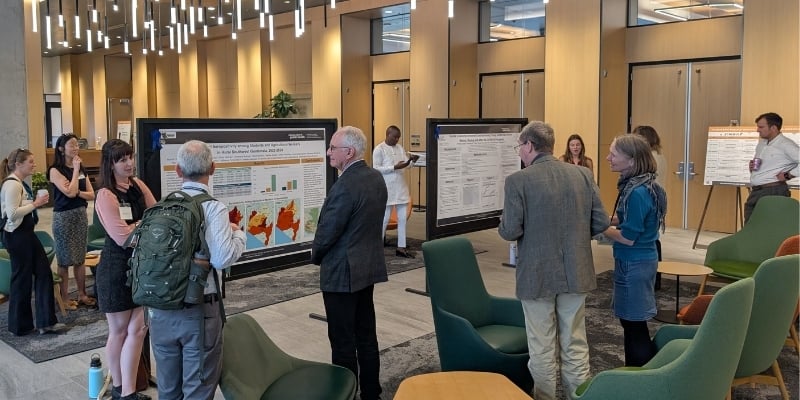Under the best of circumstances, mosquitoes are no better than annoying pests. But many also carry viruses that cause widespread disease and death in large expanses of the world. A new study with contributions from the Colorado School of Public Health describes a novel path to early diagnosis of dengue, the most common mosquito-borne viral illness, in areas of the world where lab tests to confirm the disease are not available.
The article, published in the March 2023 issue of The Lancet Global Health, is co-authored by Dr. Thomas Jaenisch, associate professor in the Department of Epidemiology and director of the Arbovirus Research Consortium in the school’s Center for Global Health. The multidisciplinary Arbovirus Research Consortium includes ColoradoSPH researchers on the University of Colorado Anschutz Medical Campus and at Colorado State University. Faculty study dengue and other diseases caused by mosquito-borne viruses including Zika, West Nile, yellow fever, and chikungunya.
The study reported in The Lancet Global Health presents evidence for a new algorithm – based on clinical symptoms, simple laboratory biomarkers and illness changes over time – that researchers argue should be used to assist providers in distinguishing dengue from other fever-related illnesses. Dengue sickens hundreds of millions of people, many of them children, with vomiting, bleeding, rashes and other symptoms that can be fatal if they go untreated.
In addition, the authors advocate for using the results to update global guidelines for dengue, like the Integrated Management of Childhood Illness handbook and the Dengue Guide, both published by the World Health Organization (WHO). Jaenisch said the research team is “in contact with those who are updating the guidelines. We are ready to feed [the findings] to WHO committees.”
A better dengue diagnosis tool
Jaenisch and his colleagues studied nearly 5,200 patients between the ages of five and 15 diagnosed with dengue and other fever-related illnesses in eight Asian and South American countries. The researchers aimed to determine the clinical signs and laboratory tests that most accurately diagnosed dengue when lab tests to confirm it were not available. The results could help to provide adequate care for patients, especially in resource-poor countries.
The study compared different models for diagnosing dengue based on clinical symptoms – cough, skin flushing, bleeding, among many others – and potentially adding simple laboratory values, such as platelet, red blood cell and white cell counts. Instead of taking single-day snapshots of the test results, the researchers recorded the symptoms of illness, how they changed over five days and how those changes correlated with the ultimate disease diagnoses.
Their work concludes that providers can most accurately diagnose dengue by combining clinical and simple laboratory data and measuring the results over time. The study notes, for example, that lower white blood cell and platelet counts “on any day between day 2 and 5 of illness was associated with dengue.” Clinical signs such as anorexia, bleeding and skin flush were also strongly associated with dengue, while symptoms like coughing and rhinitis more accurately predicted other fever-related illnesses.
Crucially, the evidence also showed that “models that included both simple laboratory predictors and clinical predictors performed better than models with clinical predictors only.
A disease that threatens half the world
Jaenisch said the researchers’ work is vital in addressing a disease that puts roughly 50% of the world population at risk. While there is no cure for dengue, its mortality rate is low with quick diagnosis and treatment, but substantially higher when adequate treatment is delayed. Therefore, improving the tools available to providers in countries most at risk, including South America, Southeast Asia, and increasingly Africa, is a major public health initiative, one that the Arbovirus Research Consortium focuses on.
“In many areas of the world, simple laboratory results like blood count parameters are available, yet more specific confirmatory diagnosis often is not,” Jaenisch said. “The study outlines the most effective route to diagnosing dengue, especially in the absence of confirmatory lab testing. It’s not perfect, and we always have some uncertainty, but we showed that this is as good as it gets with all the simple laboratory tests that are available in most settings.”
The study thus speaks to the need to develop more affordable options for point-of-care testing in resource-poor areas, Jaenisch added. “Specific diagnostic testing is still relatively expensive, depending on where you are and what your budget is.”
Technology to triage patients
Pointing to the future, the article also suggests that algorithms based on a limited number of variables might be loaded on phones and other mobile devices to give providers a relatively simple way to diagnose dengue, classify the risk and send patients to the appropriate level of care, Jaenisch said.
Providers would be encouraged to transfer patients at highest risk to the facility best equipped to manage their care, while retaining local responsibility for those with milder symptoms, he explained.
“If you have the means to diagnose, you can use the algorithm as a management tool to at least triage patients to which risk category they fall,” he said.
The growing threat of dengue
That need is likely to grow, Jaenisch added, because many southern hemisphere cities have become more hospitable for virus-bearing mosquitoes. That’s due to massive growth leading to problems like poor trash removal, he said. Discarded soda drink cans, old tires and poorly maintained construction sites all become prime breeding grounds for the mosquitoes, which then transmit disease to humans.
“Unplanned urbanization in the mega cities of the South is really a major driver of dengue,” Jaenisch said. He added that with climate change, mosquito populations have expanded their range and begun a slow northward expansion, another cause for global concern.
Jaenisch called the dengue research “a model study that needs to be repeated for other infectious diseases” as a way of saving lives in high-risk communities.
“We have set an example of providing a detailed assessment over time of disease,” Jaenisch said. “If dengue patients are well monitored and managed, we know that mortality will be much smaller. If things are delayed and not done at the right time, their mortality can be substantial.”






